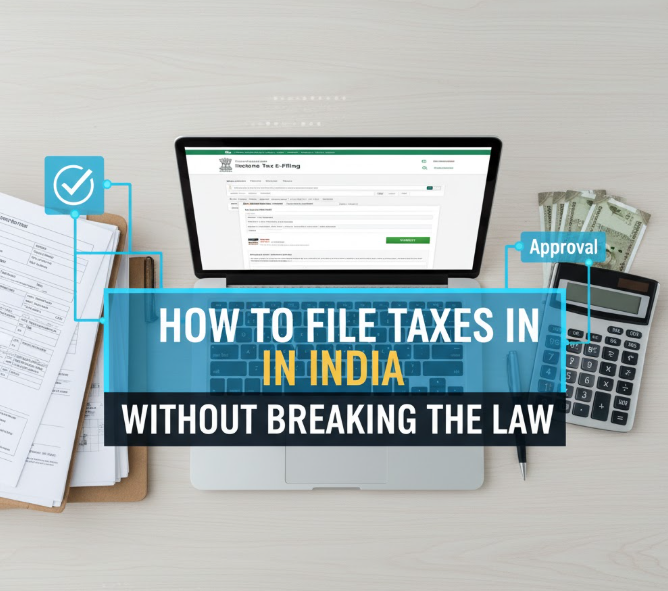How to Pay Taxes in India With Less Stress and More Joy
Filing taxes can seem scary, but it’s pretty straightforward once you know what steps to follow. Look at it like the ingredients for a recipe – they need to be followed in the right order, with a little bit of patience. Millions of Indians successfully file taxes every year, and it is very likely that you can do so! In this guide, we’re going to discuss everything you should know to file your taxes legally in India – from collecting all of your documents to clicking that final submit button.
Why Filing Taxes Properly Matters
But before we get to the “how,” let’s talk about the “why.” Doing your taxes correctly is not just following the rules, but protecting yourself and helping the country grow. Because when you pay your taxes properly, that money is used for building roads, maintaining hospitals and financing schools. There’s also the peace of mind: A clean tax record can get you a loan and a visa, and let you sleep easy at night!
⚠️ Important: If you don’t file your tax return in the year which you are supposed to, penal provisions of ₹5,000 and ₹10,000 will apply. A 1% monthly interest penalty on the tax owed is also assessed for filing late. Even if you know you have nothing due, it’s always best to file on time.
Who Should File Income Taxes?
Not everyone in India must file taxes. Here is a brief overview of who all are required to file their Income Tax Return (ITR):
| Category | Annual Income Limit | Must File? |
|---|---|---|
| Adults under 60 years | Above ₹2,50,000 | Yes |
| Adults over 60 years | Above ₹3,00,000 | Yes |
| Super senior citizens (above 80) | Above ₹5,00,000 | Yes |
| Anyone who owns foreign assets or income | Any amount | Yes |
| A business entity or company | Any amount | Yes |
💡 Pro Tip: It may be worth it to file returns, even if your income is less than the threshold for being taxed. It is a proof of income for loans, visa application and let’s you carry forward losses to adjust against future income.
Documents You’ll Need Before Starting
Half the battle is just getting organized. Here’s what you’ll want to have in hand before you start filing:
Basic Identity Documents
- PAN Card – It’s your tax ID and a must have document
- Aadhaar Card – Must for e-verification of return
- Bank Account Details – Account number, IFSC code and bank name for refund if any
Income-Related Documents
- Form 16: Issued by your employer reflecting salary and tax paid
- Form 16A/16B/16C – TDS on interest, property or rent
- Form 26AS – Your yearly tax statement reflecting every tax paid in your name
- Bank Statements – Depicting interest accrued on savings and fixed deposits
- Capital Gains Statements – In case you have sold property, shares or mutual funds
Investment Proofs for Deductions
- Life insurance policy receipts
- PPF account statements
- ELSS mutual fund statements
- Home loan interest certificates
- Health insurance premium receipts
- Children’s tuition fee receipts
Choosing Between Old and New Tax Regimes
Since April 2020 taxpayers can opt for one of two tax systems. This is one of the top decisions you’ll make when filing. Let’s break down both options:
Old and New Regime Tax Rate Comparison (For FY 2024-25)
| Income Range | Old Regime Rate | New Regime Rate |
|---|---|---|
| Up to ₹2,50,000 | Nil | Nil |
| ₹2,50,001 to ₹5,00,000 | 5% | 5% |
| ₹5,00,001 to ₹7,50,000 | 20% | 10% |
| ₹7,50,001 to ₹10,00,000 | 20% | 15% |
| ₹10,00,001 to ₹12,50,000 | 30% | 20% |
| ₹12,50,001 to ₹15,00,000 | 30% | 25% |
| Above ₹15,00,000 | 30% | 30% |
Old Regime: Higher tax rates but you can claim deduction under Section 80C (up to ₹1.5 lakh), 80D (health insurance), HRA, home loan interest and many more.
New Regime: Lower rates of tax, but virtually no deductions permitted. You will only get ₹50,000 standard deduction for employees and employer’s NPS contribution.
Which Should You Choose? If you have significant investments in LIC, PPF, ELSS or pay high home loan interest, the old regime is generally more helpful. For the more lightly invested, and fans of simplicity, the new regime could save you some tax. Calculate both ways before deciding!
For professional assistance with tax planning and compliance, visit https://zistalegalis.com.
A Step-by-Step Guide to Filing Your Tax Return
1. Registration on Income Tax Portal
Go to the official website of Income Tax e-filing at www.incometax.gov.in. If you are first time user, click on “Register” and proceed to open your account by using PAN. You will have to validate your email and mobile number. PAN card should be with you when you follow all these processes.

2. Download Your Form 26AS and AIS
After logging in, download your Form 26AS (Annual Tax Statement) and AIS (Annual Information Statement). These records reflect the tax deducted in your name, income earned as interest and other sources of money. Think of them as your report card for taxes—check all your information first to see if everything matches.
3. Pick the Right ITR Form
India has various ITR forms for various categories of taxpayers. Here’s which one you may need:
| Form Type | Who can use it |
|---|---|
| ITR-1 (Sahaj) | Individuals earning up to ₹50 lakh from salary, one house property and other sources of income |
| ITR-2 | Individuals with income from salary, more than one house property, capital gains but no business/professional income |
| ITR-3 | An individual/HUF being a partner in a firm and carrying out business/professional activity under any proprietorship |
| ITR-4 (Sugam) | This form is for professionals or self-employed taxpayers opting for the presumptive taxation scheme |
4. Fill in Your Income Details
Now comes the main part. Enter all of your sources of income thoughtfully:
- Salary Income: Fill in gross salary, allowances and deductions from Form 16 you may have
- House Property: If you have a house (or more) then mention rent received and claim deduction on home loan interest
- Capital Gains: This is where you need to report any profits made from selling stocks, mutual funds or property
- Others: Such as interest income earned on saving accounts, fixed deposits and freelance income
5. Claim Your Deductions
If you are in the old tax regime, here is where you save! Common deductions include:
- Section 80C: ₹1.5 lakh for PPF, ELSS, life insurance, and tuition fees
- Section 80D: ₹25,000 (₹50,000 for senior citizens) on health insurance
- Section 24: Home loan interest up to ₹2 lakh
- Section 80E: Complete deduction on the interest of education loan
- Standard Deduction: ₹50,000 for salaried individuals
6. Compute Your Tax and Verify TDS
The total tax for you is automatically calculated by the portal. It then compares this with TDS (Tax Deducted at Source) already paid by your employer or another party. If you have paid too much tax, you will receive a refund. If you’ve paid less, you will owe the rest.
7. Pay Any Remaining Tax
If you owe more tax, make sure to pay this online through the portal before filing your return. You can make payment through net banking, debit card or deposit cash at bank counters using Challan 280. Keep the acknowledgment number safely.
8. Verify Your Return
This one is a biggie — your return isn’t filed until it’s verified. You have several options:
- Aadhaar OTP: Instant verification via the OTP sent to your Aadhaar-linked mobile
- Net Banking: Selecting your bank from pre-login page of the bank
- Demat Account: Through your trading account login credentials
- Bank Account: Following account verification of a pre-approved bank account
- Hardcopy ITR-V: Post the signed copy to Bangalore office within 30 days (slowest method)
⚠️ Critical Step: You must e-verify your ITR within 30 days of filing it. If you don’t, your return will be considered invalid and you’ll need to file it again!
-
🧠 Learn from the top Supreme Court tax cases: Top 10 Landmark Supreme Court Cases on Tax Laws
Common Mistakes That Put You in Trouble
Even those who are telling the truth can make mistakes that draw attention from the tax department. Here are the top pitfalls to avoid:
Not Reporting All Income Sources
The interest income, stock transactions, property purchases and more are known to the Income Tax Department via your AIS. If there is income in your AIS that you should but didn’t report, it’s a red flag. Be sure to double-check your AIS before filing.
Wrong Bank Account Details
Many make the mistake of entering a wrong bank account number or IFSC code. This delays refunds significantly. Cross-verify these details and make sure that the bank account is mapped with your PAN and has been pre-validated on the portal.
Claiming Fake Deductions
Some people just puff up their 80C investments, or claim deductions which they haven’t made. This is tax evasion and could result in penalties up to 200% of the tax evaded, as well as potential criminal prosecution. Only claim things you have documentation for.
Mismatching Form 26AS
Your TDS particulars are supposed to correlate with Form 26AS. If your Form 16 reflects ₹50,000 TDS but in Form 26AS it is showing as ₹45,000, then there is a problem. Disclose precisely what’s in Form 26AS and approach your employer to solve the mismatch.
Ignoring Capital Gains
Did you sell any stocks or mutual funds this year? That’s capital gains income, and it needs to be reported, even if you put the money back into the same investment. Short-term capital gains attract tax at applicable rates, while long-term capital gains on equity exceeding ₹1.25 lakh are taxed at 12.5%.
Filing the Wrong ITR Form
The failure to use an ITR-2 when you are required to (for instance, if you have capital gains) will make your return defective. The department can kick it back, and you must again refile with the proper form.
Important Deadlines You Cannot Miss
Timing matters in tax filing. Below are the important dates for Assessment Year 2025-26 (Financial Year 2024-25):
| Event | Deadline | Late Filing Penalty |
|---|---|---|
| Regular ITR filing | 31st July 2025 | Up to ₹5,000 |
| ITR filing for audit cases | 31st October 2025 | Up to ₹10,000 |
| Belated/Revised return | 31st December 2025 | Up to ₹5,000 + interest |
| E-verification | Within 30 days of filing | Return becomes invalid |
💡 Smart Strategy: Don’t leave filing until the last day. Aim to file by early July. You’ll have time to fix errors, the portal is less congested and you get refunds quicker. Yes: The early bird truly does get the worm when it comes to tax filing!
What Happens After You File?
Here’s what you should expect after you have successfully filed and verified your return:
Acknowledgment Receipt
After you file, you will immediately receive an acknowledgment number. Save your ITR-V (acknowledgment form) for your reference. This is evidence that you filed your return.
Processing of Return
The returns are generally processed by the Department within weeks to months. You can monitor the status on the e-filing portal under “View Returns/Forms.” Processing means they are confirming your details against their files.
Refund or Demand
If you are owed a refund, it will be deposited directly into the bank account listed on your return. The majority of refunds will be received 20-45 days after processing. If you owe more tax, you will get a demand notice detailing the amount and reason.
Intimation Under Section 143(1)
This will be the final notification of your return acceptance. It indicates whether it accepted your return as filed or if they made any adjustments. Read this carefully – if there is anything you don’t agree with you have a right to appeal.
Getting Help When You Need It
You don’t have to be in it alone while filing for taxes. Here are some resources to help:
Chartered Accountants and Tax Consultants
If your return is complex (having multiple sources of income, business income, foreign assets) then you should employ a CA. Typically charging ₹500-₹5,000 depending on complexity. It’s a small price for peace of mind and error-free filing.
Income Tax Department Helpline
Call the tax department’s helpline at 1800-180-1961 (toll-free) for e-filing-related queries. They’re more helpful than you might expect, and can even help if you run into technical issues.
Tax Facilitation Centers
Volunteers serve in Tax Facilitation Centers in many cities to assist you with filing returns free of charge. They are particularly useful for seniors and newcomers to filing their own taxes.
Online Tutorials and Videos
The YouTube channel of Income Tax Department has step by step video tutorials for filing various ITR forms. These are really great for visual learners.
How to Shield Yourself From Tax Scams And Frauds
Unfortunately, tax season is also scam season. Stay alert and protected:
- Do not share your PAN or Aadhaar OTP with anyone over call or email. The department never requests this information.
- Watch out for phony refund emails that contain bad links. Always check refund status on the official portal.
- Don’t rely on third-party websites that are offering to file returns for free and requesting personal information.
- Just hang up on calls that request an immediate payment or threaten you with arrest. The tax officials communicate through notices, not phone calls.
- Only use the official site – www.incometax.gov.in. Please verify the URL before entering login information.

How to File Taxes in India Without Breaking the Law
Frequently Asked Questions
Q1: Is there a free way for me to file my tax return?
Yes, absolutely! The e-filing portal of the Income Tax Department is entirely free of cost. You should never have to pay someone just to file your return online. You would only have to pay for a Chartered Accountant if perhaps you were in the midst of more complicated cases.
Q2: I made an error on my filed return?
There is no need to worry – you can still file a revised return by the deadline (31st December of the assessment year). When filing, just choose “Revised Return” and mention the original acknowledgment number. You can make as many revisions as you want before the deadline.
Q3: I failed to file by the due date. What should I do?
You can file a belated return up to 31st December of assessment year. You will also need to pay late-filing fees of ₹5,000 (₹1,000 if your income is less than ₹5 lakh), plus interest on all unpaid tax at the rate of 1% for every month you delay filing returns. Better late than never!
Q4: Do I upload documents during online filing?
No, you do not have to send your supporting documents when you e-file. Although retain all such originals like Form 16, investment proofs and bank statements safely for a minimum of 6 years. The tax department could demand them during assessment or scrutiny.
Q5: When will I receive my refund?
Your refund will be processed once your return is processed (2-4 weeks) and usually appears in your account within 20-45 days. But it can take longer if there are issues with your bank details, discrepancies in your return or if your return has been selected for review.
Q6: Can I switch between old and new tax regimes every year?
Yes, if you have salary income you can choose to switch every year. But if you have business income, once you take the new regime, you must continue with it. Pick thoughtfully and run the numbers on both scenarios each year.
Q7: What if I don’t file my return at all?
Failure to file when required can bring penalties of up to ₹10,000, interest on tax not paid, loss of carry-forward set-off for losses and could lead to prosecution in extreme cases. Your PAN card also becomes inoperative, which influences your financial dealings. Always file on time.
Q8: Is Form 26AS equivalent to Form 16?
No, they’re different. Your employer issues you Form 16 reflecting your salary details and TDS deducted. Form 26AS is a consolidated tax statement issued by the Income Tax Department, comprising details of tax deducted or collected at source, advance tax paid and self-assessment tax. Always verify both match.
Final Thoughts: Tax Filing Doesn’t Have to Cause Stress
The process might seem complex, but once you break it down filing your income tax return in India isn’t as bad as it might seem. The trick is to get and stay organized, collect your documents early and read the steps carefully. Keep in mind, the government designed the e-filing system to be user friendly and help is available if you need it.
For expert guidance on tax compliance and legal matters, visit https://zistalegalis.com.



